Climatic–Environmental Effects of Aerosols and Their Sensitivity to Aerosol Mixing States in East Asia in Winter
Abstract
:1. Introduction
2. Methods and Materials
2.1. Model Description and Aerosol Optical Depth (AOD) Calculation in RegCCMS
2.1.1. Externally Mixing Aerosols
2.1.2. Internally Mixing Aerosols
2.1.3. Partially Internally Mixing Aerosols
2.2. Simulation Schemes
3. Results
3.1. Model Validation
3.1.1. Meteorological Element Field
3.1.2. Aerosol Concentration and AOD
3.1.3. Single Scattering Albedo (SSA)
3.2. Aerosol Radiative Forcing (RF)
3.2.1. Instantaneous Direct Radiative Forcing (IRF) and Effective Radiative Forcing (ERF) of Aerosol
3.2.2. Shortwave Heating Rate
3.3. Climate Effects of Aerosols
3.3.1. Cloud Cover
3.3.2. Sensible Heat Flux and Near-Surface Air Temperature
3.3.3. Atmospheric Circulation
3.4. Environmental Effects of Aerosols
4. Brief Discussion
5. Conclusions
Author Contributions
Funding
Data Availability Statement
Conflicts of Interest
Abbreviations
| BC | black carbon aerosol |
| OC | organic carbon aerosol |
| SOA | secondary organic aerosol |
| POA | primary organic carbon |
| CCN | cloud condensation nuclei |
| INPs | ice nucleating particles |
| EAM | East Asian Monsoon |
| EAWM | East Asian Winter Monsoon |
| CLR | control experiment |
| EM | sensitivity experiment (external mixing) |
| IM | sensitivity experiment (internal mixing) |
| PIM | sensitivity experiment (partial internal mixing) |
| AOD | aerosol optical depth |
| SSA | aerosol single scattering albedo |
| RF | radiative forcing |
| IRF | direct radiative forcing |
| ERF | effective radiative forcing |
| QRS | shortwave heating rate |
References
- Zhang, Q.; Meng, J.; Quan, J.; Gao, Y.; Zhao, D.; Chen, P.; He, H. Impact of aerosol composition on cloud condensation nuclei activity. Atmos. Chem. Phys. 2012, 12, 3783–3790. [Google Scholar] [CrossRef] [Green Version]
- Zhang, H.; Yin, Q.; Nakajima, T.; Makiko, N.M.; Lu, P.; He, J. Influence of changes in solar radiation on changes of surface temperature in China. Acta Meteorol. Sin. 2013, 27, 87–97. [Google Scholar] [CrossRef]
- Li, B.G.; Gasser, T.; Ciais, P.; Piao, S.L.; Tao, S.; Balkanski, Y.; Hauglustaine, D.; Boisier, J.P.; Chen, Z.; Huang, M.T.; et al. The contribution of China’s emissions to global climate forcing. Nature 2016, 531, 357. [Google Scholar] [CrossRef] [PubMed]
- Hagler, G.S.; Bergin, M.H.; Salmon, L.G.; Yu, J.Z.; Wan, E.C.H.; Zheng, M.; Zeng, L.M.; Kiang, C.S.; Zhang, Y.H.; Lau, A.K.H.; et al. Source areas and chemical composition of fine particulate matter in the Pearl River Delta region of China. Atmos. Environ. 2006, 40, 3802–3815. [Google Scholar] [CrossRef]
- Zhang, H.; Wang, Z.L.; Guo, P.W.; Wang, Z.Z. A Modeling Study of the Effects of Direct Radiative Forcing Due to Carbonaceous Aerosol on the Climate in East Asia. Adv. Atmos. Sci. 2009, 26, 57–66. [Google Scholar] [CrossRef]
- Zhang, Q.; Streets, D.G.; Carmichael, G.R.; He, K.B.; Huo, H.; Kannari, A.; Klimont, Z.; Park, I.S.; Reddy, S.; Fu, J.S.; et al. Asian emissions in 2006 for the NASA INTEX-B mission. Atmos. Chem. Phys. 2009, 9, 5131–5153. [Google Scholar] [CrossRef] [Green Version]
- Zhou, C.; Zhang, H.; Wang, Z. Impact of Different Mixing Ways of Black Carbon and Non-Absorbing Aerosols on the Optical Properties. Acta Opt. Sin. 2013, 33, 0829001-1–0829001-12. [Google Scholar] [CrossRef]
- Lee, S.; Lee, M.I.; Song, C.K.; Kim, K.M.; da Silva, A.M. Interannual variation of the East Asia Jet Stream and its impact on the horizontal distribution of aerosol in boreal spring. Atmos. Environ. 2020, 223, 1–11. [Google Scholar] [CrossRef]
- Myhre, G.; Samset, B.H.; Schulz, M.; Balkanski, Y.; Bauer, S.; Berntsen, T.K.; Bian, H.; Bellouin, N.; Chin, M.; Diehl, T.; et al. Radiative forcing of the direct aerosol effect from AeroCom Phase II simulations. Atmos. Chem. Phys. 2013, 13, 1853–1877. [Google Scholar] [CrossRef] [Green Version]
- Li, Z. Impact of aerosols on the weather, climate and environment of China: An overview. Trans. Atmos. Sci. 2020, 43, 76–92. [Google Scholar]
- Twomey, S. Influence of Pollution on Shortwave Albedo of Clouds. J. Atmos. Sci. 1977, 34, 1149–1152. [Google Scholar] [CrossRef] [Green Version]
- Albrecht, B.A. Aerosols, Cloud Microphysics, and Fractional Cloudiness. Science 1989, 245, 1227–1230. [Google Scholar] [CrossRef] [PubMed]
- Ramanathan, V.; Crutzen, P.J.; Kiehl, J.T.; Rosenfeld, D. Atmosphere—Aerosols, climate, and the hydrological cycle. Science 2001, 294, 2119–2124. [Google Scholar] [CrossRef] [PubMed] [Green Version]
- Rosenfeld, D. Suppression of rain and snow by urban and industrial air pollution. Science 2000, 287, 1793–1796. [Google Scholar] [CrossRef]
- Mahowald, N. Aerosol Indirect Effect on Biogeochemical Cycles and Climate. Science 2011, 334, 794–796. [Google Scholar] [CrossRef]
- Carslaw, K.S.; Lee, L.A.; Reddington, C.L.; Pringle, K.J.; Rap, A.; Forster, P.M.; Mann, G.W.; Spracklen, D.V.; Woodhouse, M.T.; Regayre, L.A.; et al. Large contribution of natural aerosols to uncertainty in indirect forcing. Nature 2013, 503, 67–71. [Google Scholar] [CrossRef] [PubMed]
- Jacobson, M.Z. Strong radiative heating due to the mixing state of black carbon in atmospheric aerosols. Nature 2001, 409, 695–697. [Google Scholar] [CrossRef]
- Li, Z.Q.; Xia, X.G.; Cribb, M.R.; Mi, W.; Holben, B.; Wang, P.C.; Chen, H.B.; Tsay, S.C.; Eck, T.F.; Zhao, F.S.; et al. Aerosol optical properties and their radiative effects in northern China (vol 112, art no. D22S01, 2007). J. Geophys. Res.-Atmos. 2008, 113, 1. [Google Scholar] [CrossRef] [Green Version]
- Li, Z.; Li, C.; Chen, H.; Tsay, S.C.; Holben, B.; Huang, J.; Li, B.; Maring, H.; Qian, Y.; Shi, G.; et al. East Asian Studies of Tropospheric Aerosols and their Impact on Regional Climate (EAST-AIRC): An overview. J. Geophys. Res.-Atmos. 2011, 116, 1–15. [Google Scholar] [CrossRef] [Green Version]
- Huang, J.; Wang, T.; Wang, W.; Li, Z.; Yan, H. Climate effects of dust aerosols over East Asian arid and semiarid regions. J. Geophys. Res.-Atmos. 2014, 119, 11398–11416. [Google Scholar] [CrossRef]
- Guo, J.; Deng, M.; Lee, S.S.; Wang, F.; Li, Z.; Zhai, P.; Liu, H.; Lv, W.; Yao, W.; Li, X. Delaying precipitation and lightning by air pollution over the Pearl River Delta. Part I: Observational analyses. J. Geophys. Res.-Atmos. 2016, 121, 6472–6488. [Google Scholar] [CrossRef]
- Dong, B.W.; Wilcox, L.J.; Highwood, E.J.; Sutton, R.T. Impacts of recent decadal changes in Asian aerosols on the East Asian summer monsoon: Roles of aerosol-radiation and aerosol-cloud interactions. Clim. Dyn. 2019, 53, 3235–3256. [Google Scholar] [CrossRef] [Green Version]
- Deng, J.C.; Dai, A.G.; Xu, H.M. Nonlinear Climate Responses to Increasing CO2 and Anthropogenic Aerosols Simulated by CESM1. J. Clim. 2020, 33, 281–301. [Google Scholar] [CrossRef]
- Mu, J.Y.; Wang, Z.L. Responses of the East Asian summer monsoon to aerosol forcing inCMIP5models: The role of upper-tropospheric temperature change. Int. J. Climatol. 2021, 41, 1555–1570. [Google Scholar] [CrossRef]
- Wang, T.J.; Zhuang, B.L.; Li, S.; Liu, J.; Xie, M.; Yin, C.Q.; Zhang, Y.; Yuan, C.; Zhu, J.L.; Ji, L.Q.; et al. The interactions between anthropogenic aerosols and the East Asian summer monsoon using RegCCMS. J. Geophys. Res.-Atmos. 2015, 120, 5602–5621. [Google Scholar] [CrossRef]
- Ding, A.J.; Fu, C.B.; Yang, X.Q.; Sun, J.N.; Petaja, T.; Kerminen, V.M.; Wang, T.; Xie, Y.; Herrmann, E.; Zheng, L.F.; et al. Intense atmospheric pollution modifies weather: A case of mixed biomass burning with fossil fuel combustion pollution in eastern China. Atmos. Chem. Phys. 2013, 13, 10545–10554. [Google Scholar] [CrossRef] [Green Version]
- Zhuang, B.L.; Li, S.; Wang, T.J.; Liu, J.; Chen, H.M.; Chen, P.L.; Li, M.M.; Xie, M. Interaction between the Black Carbon Aerosol Warming Effect and East Asian Monsoon Using RegCM4. J. Clim. 2018, 31, 9367–9388. [Google Scholar] [CrossRef]
- Huang, W.; Shen, X.; Huang, W.; Zhou, S. Effects of anthropogenic aerosols over Asia on east Asian winter monsoon. J. Meteorol. Sci. 2013, 33, 500–509. [Google Scholar]
- Luo, M.; Wu, J. The Regional Sea Air Coupled Model(RIEMS_2.0-POM2K)Simulated the Affecting of Black Carbon Aerosol on the Spring and Summer Climate over East Asia. Plateau Meteorol. 2020, 39, 870–888. [Google Scholar]
- Liu, Z.; Ming, Y.; Wang, L.; Bollasina, M.; Luo, M.; Lau, N.C.; Yim, S.H.L. A Model Investigation of Aerosol-Induced Changes in the East Asian Winter Monsoon. Geophys. Res. Lett. 2019, 46, 10186–10195. [Google Scholar] [CrossRef] [Green Version]
- Zhao, C.; Wang, Y.; Yang, Q.; Fu, R.; Cunnold, D.; Choi, Y. Impact of East Asian summer monsoon on the air quality over China: View from space. J. Geophys. Res.-Atmos. 2010, 115, 1–12. [Google Scholar] [CrossRef] [Green Version]
- Zhang, L.; Liao, H.; Li, J. Impacts of Asian summer monsoon on seasonal and interannual variations of aerosols over eastern China. J. Geophys. Res.-Atmos. 2010, 115, 1–20. [Google Scholar] [CrossRef] [Green Version]
- Zhu, J.; Liao, H.; Li, J. Increases in aerosol concentrations over eastern China due to the decadal-scale weakening of the East Asian summer monsoon. Geophys. Res. Lett. 2012, 39, 1–6. [Google Scholar] [CrossRef] [Green Version]
- Han, H.; Wu, Y.; Liu, J.; Zhao, T.L.; Zhuang, B.L.; Wang, H.L.; Li, Y.C.; Chen, H.M.; Zhu, Y.; Liu, H.N.; et al. Impacts of atmospheric transport and biomass burning on the inter-annual variation in black carbon aerosols over the Tibetan Plateau. Atmos. Chem. Phys. 2020, 20, 13591–13610. [Google Scholar] [CrossRef]
- Hilario, M.R.A.; Crosbie, E.; Shook, M.; Reid, J.S.; Cambaliza, M.O.L.; Simpas, J.B.B.; Ziemba, L.; DiGangi, J.P.; Diskin, G.S.; Nguyen, P.; et al. Measurement report: Long-range transport patterns into the tropical northwest Pacific during the CAMP(2)Ex aircraft campaign: Chemical composition, size distributions, and the impact of convection. Atmos. Chem. Phys. 2021, 21, 3777–3802. [Google Scholar] [CrossRef]
- Wu, G.; Li, Z.; Fu, C.; Zhang, X.; Zhang, R.; Zhang, R.; Zhou, T.; Li, J.; Li, J.; Zhou, D.; et al. Advances in studying interactions between aerosols and monsoon in China. Sci. China-Earth Sci. 2016, 59, 1–16. [Google Scholar] [CrossRef]
- Liu, Z.; Wang, T.; Xie, M.; Li, S.; Zhuang, B.; Han, Y. Influence of winter monsoon on aerosol transport and distribution in East Asia. J. Nanjing University. Nat. Sci. 2015, 51, 575–586. [Google Scholar]
- Yuan, T.G.; Chen, S.Y.; Wang, L.; Yang, Y.X.; Bi, H.R.; Zhang, X.R.; Zhang, Y. Impacts of Two East Asian Atmospheric Circulation Modes on Black Carbon Aerosol Over the Tibetan Plateau in Winter. J. Geophys. Res.-Atmos. 2020, 125, 1–21. [Google Scholar] [CrossRef]
- Lou, S.J.; Yang, Y.; Wang, H.L.; Smith, S.J.; Qian, Y.; Rasch, P.J. Black Carbon Amplifies Haze Over the North China Plain by Weakening the East Asian Winter Monsoon. Geophys. Res. Lett. 2019, 46, 452–460. [Google Scholar] [CrossRef] [Green Version]
- Yu, Y.; Niu, S.; Zhang, H.; Wu, Z. Regional climate effects of internally and externally mixed aerosols over China. Acta Meteorol. Sin. 2013, 27, 110–118. [Google Scholar] [CrossRef]
- Zhang, H.; Zhou, C.; Wang, Z.; Zhao, S.; Li, J. The influence of different black carbon and sulfate mixing methods on their optical and radiative properties. J. Quant. Spectrosc. Radiat. Transf. 2015, 161, 105–116. [Google Scholar] [CrossRef]
- Riemer, N.; Ault, A.P.; West, M.; Craig, R.L.; Curtis, J.H. Aerosol Mixing State: Measurements, Modeling, and Impacts. Rev. Geophys. 2019, 57, 187–249. [Google Scholar] [CrossRef]
- Chandra, S.; Satheesh, S.K.; Srinivasan, J. Can the state of mixing of black carbon aerosols explain the mystery of ‘excess’ atmospheric absorption? Geophys. Res. Lett. 2004, 31, 1–4. [Google Scholar] [CrossRef]
- Zhuang, B.L.; Li, S.; Wang, T.J.; Deng, J.J.; Xie, M.; Yin, C.Q.; Zhu, J.L. Direct radiative forcing and climate effects of anthropogenic aerosols with different mixing states over China. Atmos. Environ. 2013, 79, 349–361. [Google Scholar] [CrossRef]
- Zhu, J.; Penner, J.E.; Lin, G.; Zhou, C.; Xu, L.; Zhuang, B. Mechanism of SOA formation determines magnitude of radiative effects. Proc. Natl. Acad. Sci. USA 2017, 114, 12685–12690. [Google Scholar] [CrossRef] [Green Version]
- Giorgi, F.; Bi, X.Q.; Qian, Y. Direct radiative forcing and regional climatic effects of anthropogenic aerosols over East Asia: A regional coupled climate-chemistry/aerosol model study. J. Geophys. Res.-Atmos. 2002, 107, 1–18. [Google Scholar] [CrossRef]
- Wang, T.; Xie, M.; Gao, L.; Yang, H. Development and Preliminary Application of a Coupled Regional Climate-Chemistry Model System. J. Nanjing Univ. 2004, 40, 711–727. [Google Scholar]
- Wang, T.; Li, S.; Shen, Y.; Deng, J.; Xie, M. Investigations on direct and indirect effect of nitrate on temperature and precipitation in China using a regional climate chemistry modeling system. J. Geophys. Res.-Atmos. 2010, 115, 1–13. [Google Scholar] [CrossRef] [Green Version]
- Wang, T.J.; Min, J.Z.; Xu, Y.F.; Lam, K.S. Seasonal variations of anthropogenic sulfate aerosol and direct radiative forcing over China. Meteorol. Atmos. Phys. 2003, 84, 185–198. [Google Scholar] [CrossRef]
- Kasten, F. Visibility Forecast in Phase of Pre-Condensation. Tellus 1969, 21, 630. [Google Scholar] [CrossRef] [Green Version]
- Kiehl, J.T.; Briegleb, B.P. The Relative Roles of Sulfate Aerosols and Greenhouse Gases in Climate Forcing. Science 1993, 260, 311–314. [Google Scholar] [CrossRef] [PubMed]
- Kiehl, J.T.; Schneider, T.L.; Rasch, P.J.; Barth, M.C.; Wong, J. Radiative forcing due to sulfate aerosols from simulations with the National Center for Atmospheric Research Community Climate Model, Version 3. J. Geophys. Res.-Atmos. 2000, 105, 1441–1457. [Google Scholar] [CrossRef]
- Worringen, A.; Ebert, M.; Trautmann, T.; Weinbruch, S.; Helas, G. Optical properties of internally mixed ammonium sulfate and soot particles-a study of individual aerosol particles and ambient aerosol populations. Appl. Opt. 2008, 47, 3835–3845. [Google Scholar] [CrossRef] [PubMed]
- Conant, W.C.; Nenes, A.; Seinfeld, J.H. Black carbon radiative heating effects on cloud microphysics and implications for the aerosol indirect effect—1. Extended Kohler theory. J. Geophys. Res.-Atmos. 2002, 107, 1–9. [Google Scholar] [CrossRef]
- Reddy, M.S.; Boucher, O. A study of the global cycle of carbonaceous aerosols in the LMDZT general circulation model. J. Geophys. Res.-Atmos. 2004, 109, 1–22. [Google Scholar] [CrossRef]
- Kim, D.; Wang, C.; Ekman, A.M.L.; Barth, M.C.; Rasch, P.J. Distribution and direct radiative forcing of carbonaceous and sulfate aerosols in an interactive size-resolving aerosol-climate model. J. Geophys. Res.-Atmos. 2008, 113, 1–36. [Google Scholar] [CrossRef] [Green Version]
- Reynolds, R.W.; Rayner, N.A.; Smith, T.M.; Stokes, D.C.; Wang, W.Q. An improved in situ and satellite SST analysis for climate. J. Clim. 2002, 15, 1609–1625. [Google Scholar] [CrossRef]
- Zhuang, B.; Jiang, F.; Wang, T.; Li, S.; Zhu, B. Investigation on the direct radiative effect of fossil fuel black-carbon aerosol over China. Theor. Appl. Climatol. 2011, 104, 301–312. [Google Scholar] [CrossRef]
- Zhuang, B.; Liu, Q.; Wang, T.; Yin, C.; Li, S.; Xie, M.; Jiang, F.; Mao, H. Investigation on semi-direct and indirect climate effects of fossil fuel black carbon aerosol over China. Theor. Appl. Climatol. 2013, 114, 651–672. [Google Scholar] [CrossRef]
- Zhang, X.Y.; Wang, Y.Q.; Niu, T.; Zhang, X.C.; Gong, S.L.; Zhang, Y.M.; Sun, J.Y. Atmospheric aerosol compositions in China: Spatial/temporal variability, chemical signature, regional haze distribution and comparisons with global aerosols. Atmos. Chem. Phys. 2012, 12, 779–799. [Google Scholar] [CrossRef] [Green Version]
- Han, X.; Zhang, M.; Han, Z.; Xin, J.; Liu, X. Simulation of aerosol direct radiative forcing with RAMS-CMAQ in East Asia. Atmos. Environ. 2011, 45, 6576–6592. [Google Scholar] [CrossRef]
- Zhang, X.Y.; Wang, Y.Q.; Zhang, X.C.; Guo, W.; Gong, S.L. Carbonaceous aerosol composition over various regions of China during 2006. J. Geophys. Res.-Atmos. 2008, 113, 1–10. [Google Scholar] [CrossRef]
- Xin, J.; Wang, Y.; Li, Z.; Wang, P.; Hao, W.M.; Nordgren, B.L.; Wang, S.; Liu, G.; Wang, L.; Wen, T.; et al. Aerosol optical depth (AOD) and Angstrom exponent of aerosols observed by the Chinese Sun Hazemeter Network from August 2004 to September 2005. J. Geophys. Res.-Atmos. 2007, 112, 1–13. [Google Scholar] [CrossRef]
- Bond, T.C.; Doherty, S.J.; Fahey, D.W.; Forster, P.M.; Berntsen, T.; DeAngelo, B.J.; Flanner, M.G.; Ghan, S.; Kaercher, B.; Koch, D.; et al. Bounding the role of black carbon in the climate system: A scientific assessment. J. Geophys. Res.-Atmos. 2013, 118, 5380–5552. [Google Scholar] [CrossRef]
- An, Q.; Zhang, H.; Wang, Z.; Liu, Y.; Xie, B.; Liu, Q.; Wang, Z.; Gong, S. The Development of an Atmospheric Aerosol/Chemistry-Climate Model, BCC_AGCM_CUACE2.0, and Simulated Effective Radiative Forcing of Nitrate Aerosols. J. Adv. Modeling Earth Syst. 2019, 11, 3816–3835. [Google Scholar] [CrossRef] [Green Version]
- Nakajima, T.; Sekiguchi, M.; Takemura, T.; Uno, I.; Higurashi, A.; Kim, D.; Sohn, B.J.; Oh, S.N.; Nakajima, T.Y.; Ohta, S.; et al. Significance of direct and indirect radiative forcings of aerosols in the East China Sea region. J. Geophys. Res.-Atmos. 2003, 108, 1–16. [Google Scholar] [CrossRef]
- Yoon, S.C.; Won, J.G.; Omar, A.H.; Kim, S.W.; Sohn, B.J. Estimation of the radiative forcing by key aerosol types in worldwide locations using a column model and AERONET data. Atmos. Environ. 2005, 39, 6620–6630. [Google Scholar] [CrossRef]
- Li, Z.; Lee, K.-H.; Wang, Y.; Xin, J.; Hao, W.-M. First observation-based estimates of cloud-free aerosol radiative forcing across China. J. Geophys. Res.-Atmos. 2010, 115, 1–9. [Google Scholar] [CrossRef]
- Bi, J.R.; Shi, J.S.; Xie, Y.K.; Liu, Y.Z.; Takamura, T.; Khatri, P. Dust Aerosol Characteristics and Shortwave Radiative Impact at a Gobi Desert of Northwest China during the Spring of 2012. J. Meteorol. Soc. Jpn. 2014, 92A, 33–56. [Google Scholar] [CrossRef] [Green Version]
- Niu, F.; Li, Z.; Li, C.; Lee, K.-H.; Wang, M. Increase of wintertime fog in China: Potential impacts of weakening of the Eastern Asian monsoon circulation and increasing aerosol loading. J. Geophys. Res.-Atmos. 2010, 115, 1–12. [Google Scholar] [CrossRef]
- Kim, S.-W.; Choi, I.-J.; Yoon, S.-C. A multi-year analysis of clear-sky aerosol optical properties and direct radiative forcing at Gosan, Korea (2001–2008). Atmos. Res. 2010, 95, 279–287. [Google Scholar] [CrossRef]
- Liang, F.; Xia, X.A. Long-term trends in solar radiation and the associated climatic factors over China for 1961–2000. Ann. Geophys. 2005, 23, 2425–2432. [Google Scholar] [CrossRef] [Green Version]
- Qian, Y.; Kaiser, D.P.; Leung, L.R.; Xu, M. More frequent cloud-free sky and less surface solar radiation in China from 1955 to 2000. Geophys. Res. Lett. 2006, 33, 1–4. [Google Scholar] [CrossRef] [Green Version]
- Xia, X. Significant decreasing cloud cover during 1954–2005 due to more clear-sky days and less overcast days in China and its relation to aerosol. Ann. Geophys. 2012, 30, 573–582. [Google Scholar] [CrossRef] [Green Version]
- Ackerman, A.S.; Toon, O.B.; Stevens, D.E.; Heymsfield, A.J.; Ramanathan, V.; Welton, E.J. Reduction of tropical cloudiness by soot. Science 2000, 288, 1042–1047. [Google Scholar] [CrossRef] [PubMed] [Green Version]
- Jing, D.; Jietai, M.A. Progress in Researches on Interaction between Aerosol and Cloud. Adv. Earth Sci. 2008, 23, 252–261. [Google Scholar]
- Li, Z.Q.; Wang, Y.; Guo, J.P.; Zhao, C.F.; Cribb, M.; Dong, X.Q.; Fan, J.W.; Gong, D.Y.; Huang, J.P.; Jiang, M.J.; et al. East Asian Study of Tropospheric Aerosols and their Impact on Regional Clouds, Precipitation, and Climate (EAST-AIR(CPC)). J. Geophys. Res.-Atmos. 2019, 124, 13026–13054. [Google Scholar] [CrossRef] [Green Version]
- Koren, I.; Martins, J.V.; Remer, L.A.; Afargan, H. Smoke invigoration versus inhibition of clouds over the Amazon. Science 2008, 321, 946–949. [Google Scholar] [CrossRef] [Green Version]
- Gong, D.-Y.; Wang, W.; Qian, Y.; Bai, W.; Guo, Y.; Mao, R. Observed holiday aerosol reduction and temperature cooling over East Asia. J. Geophys. Res.-Atmos. 2014, 119, 6306–6324. [Google Scholar] [CrossRef]
- Liu, L.; Li, Z.; Yang, X.; Gong, H.; Li, C.; Xiong, A. The long-term trend in the diurnal temperature range over Asia and its natural and anthropogenic causes. J. Geophys. Res.-Atmos. 2016, 121, 3519–3533. [Google Scholar] [CrossRef] [Green Version]
- Sand, M.; Berntsen, T.K.; Ekman, A.M.L.; Hansson, H.C.; Lewinschal, A. Surface temperature response to regional black carbon emissions: Do location and magnitude matter? Atmos. Chem. Phys. 2020, 20, 3079–3089. [Google Scholar] [CrossRef] [Green Version]
- Zhou, C.J.; Liu, P.; Huang, G.; Lin, J.T.; Hu, K.M.; Chen, L.L.; Wang, J.X.; Li, S.X.; Wang, S.; Ni, R.J. The impact of secondary inorganic aerosol emissions change on surface air temperature in the Northern Hemisphere. Theor. Appl. Climatol. 2020, 141, 857–868. [Google Scholar] [CrossRef]
- Li, Q.; Zhang, R.; Wang, Y. Interannual variation of the wintertime fog-haze days across central and eastern China and its relation with East Asian winter monsoon. Int. J. Climatol. 2016, 36, 346–354. [Google Scholar] [CrossRef]
- Yu, H.B.; Liu, S.C.; Dickinson, R.E. Radiative effects of aerosols on the evolution of the atmospheric boundary layer. J. Geophys. Res.-Atmos. 2002, 107, 1–14. [Google Scholar] [CrossRef]
- Ding, A.J.; Huang, X.; Nie, W.; Sun, J.N.; Kerminen, V.M.; Petaja, T.; Su, H.; Cheng, Y.F.; Yang, X.Q.; Wang, M.H.; et al. Enhanced haze pollution by black carbon in megacities in China. Geophys. Res. Lett. 2016, 43, 2873–2879. [Google Scholar] [CrossRef]
- Li, Z.; Guo, J.; Ding, A.; Liao, H.; Liu, J.; Sun, Y.; Wang, T.; Xue, H.; Zhang, H.; Zhu, B. Aerosol and boundary-layer interactions and impact on air quality. Natl. Sci. Rev. 2017, 4, 810–833. [Google Scholar] [CrossRef]
- Lau, W.K.M. The Aerosol-Monsoon Climate System of Asia: A New Paradigm. J. Meteorol. Res. 2016, 30, 1–11. [Google Scholar] [CrossRef]
- Bao, L.; Gneiting, T.; Grimit, E.P.; Guttorp, P.; Raftery, A.E. Bias Correction and Bayesian Model Averaging for Ensemble Forecasts of Surface Wind Direction. Mon. Weather Rev. 2010, 138, 1811–1821. [Google Scholar] [CrossRef]
- Zhang, H.; Wang, Z.; Wang, Z.; Liu, Q.; Gong, S.; Zhang, X.; Shen, Z.; Lu, P.; Wei, X.; Che, H.; et al. Simulation of direct radiative forcing of aerosols and their effects on East Asian climate using an interactive AGCM-aerosol coupled system. Clim. Dyn. 2012, 38, 1675–1693. [Google Scholar] [CrossRef]
- Wang, Y.; Zhang, R.; Saravanan, R. Asian pollution climatically modulates mid-latitude cyclones following hierarchical modelling and observational analysis. Nat. Commun. 2014, 5, 1–7. [Google Scholar] [CrossRef] [Green Version]
- Ding, Y.; Li, X.; Li, Q. Advances of Surface Wind Speed Changes over China Under Global Warming. J. Appl. Meteorolgical Sci. 2020, 31, 1–12. [Google Scholar]
- Xu, M.; Chang, C.-P.; Fu, C.; Qi, Y.; Robock, A.; Robinson, D.; Zhang, H.-m. Steady decline of east Asian monsoon winds, 1969-2000: Evidence from direct ground measurements of wind speed. J. Geophys. Res.-Atmos. 2006, 111, 1–8. [Google Scholar] [CrossRef] [Green Version]
- Jacobson, M.Z.; Kaufman, Y.J. Wind reduction by aerosol particles. Geophys. Res. Lett. 2006, 33, 1–6. [Google Scholar] [CrossRef] [Green Version]
- Chen, H.; Wang, H. Haze Days in North China and the associated atmospheric circulations based on daily visibility data from 1960 to 2012. J. Geophys. Res.-Atmos. 2015, 120, 5895–5909. [Google Scholar] [CrossRef]
- An, L.; Jiang, J.; Zhou, Y. Impacts of East Asian summer monsoon circulation on aerosol distribution. J. Meteorol. Sci. 2015, 35, 26–32. [Google Scholar]
- Jeong, J.I.; Park, R.J. Winter monsoon variability and its impact on aerosol concentrations in East Asia. Environ. Pollut. 2017, 221, 285–292. [Google Scholar] [CrossRef]
- Liu, Q.; Sheng, L.; Cao, Z.; Diao, Y.; Wang, W.; Zhou, Y. Dual effects of the winter monsoon on haze-fog variations in eastern China. J. Geophys. Res.-Atmos. 2017, 122, 5857–5869. [Google Scholar] [CrossRef]
- Wang, J.; Zhang, X.; Li, D.; Yang, Y.; Zhong, J.; Wang, Y.; Che, H.; Che, H.; Zhang, Y. Interdecadal changes of summer aerosol pollution in the Yangtze River Basin of China, the relative influence of meteorological conditions and the relation to climate change. Sci. Total Environ. 2018, 630, 46–52. [Google Scholar] [CrossRef]
- Hu, W.Y.; Zhao, T.L.; Bai, Y.Q.; Kong, S.F.; Xiong, J.; Sun, X.Y.; Yang, Q.J.; Gu, Y.; Lu, H.C. Importance of regional PM2.5 transport and precipitation washout in heavy air pollution in the Twain-Hu Basin over Central China: Observational analysis and WRF-Chem simulation. Sci. Total Environ. 2021, 758, 1–8. [Google Scholar] [CrossRef]
- Li, Z.Q.; Lau, W.K.M.; Ramanathan, V.; Wu, G.; Ding, Y.; Manoj, M.G.; Liu, J.; Qian, Y.; Li, J.; Zhou, T.; et al. Aerosol and monsoon climate interactions over Asia. Rev. Geophys. 2016, 54, 866–929. [Google Scholar] [CrossRef]
- Liu, J.; Zheng, Y.; Li, Z.; Flynn, C.; Cribb, M. Seasonal variations of aerosol optical properties, vertical distribution and associated radiative effects in the Yangtze Delta region of China. J. Geophys. Res.-Atmos. 2012, 117, 1–16. [Google Scholar] [CrossRef]
- Wang, Y.; Wan, Q.; Meng, W.; Liao, F.; Tan, H.; Zhang, R. Long-term impacts of aerosols on precipitation and lightning over the Pearl River Delta megacity area in China. Atmos. Chem. Phys. 2011, 11, 12421–12436. [Google Scholar] [CrossRef] [Green Version]
- Wang, Y.; Fan, J.; Zhang, R.; Leung, L.R.; Franklin, C. Improving bulk microphysics parameterizations in simulations of aerosol effects. J. Geophys. Res.-Atmos. 2013, 118, 5361–5379. [Google Scholar] [CrossRef]
- Lin, L.; Xu, Y.; Wang, Z.; Diao, C.; Dong, W.; Xie, S.-P. Changes in Extreme Rainfall Over India and China Attributed to Regional Aerosol-Cloud Interaction During the Late 20th Century Rapid Industrialization. Geophys. Res. Lett. 2018, 45, 7857–7865. [Google Scholar] [CrossRef] [Green Version]
- Zhao, A.D.; Stevenson, D.S.; Bollasina, M.A. The role of anthropogenic aerosols in future precipitation extremes over the Asian Monsoon Region. Clim. Dyn. 2019, 52, 6257–6278. [Google Scholar] [CrossRef] [Green Version]
- Li, Z.; Niu, F.; Fan, J.; Liu, Y.; Rosenfeld, D.; Ding, Y. Long-term impacts of aerosols on the vertical development of clouds and precipitation. Nat. Geosci. 2011, 4, 888–894. [Google Scholar] [CrossRef]
- Qian, Y.; Gong, D.; Fan, J.; Leung, L.R.; Bennartz, R.; Chen, D.; Wang, W. Heavy pollution suppresses light rain in China: Observations and modeling. J. Geophys. Res.-Atmos. 2009, 114, 1–16. [Google Scholar] [CrossRef]
- Ding, Y.H.; Liu, Y.J.; Song, Y.F.; Zhang, J. From MONEX to the Global Monsoon: A Review of Monsoon System Research. Adv. Atmos. Sci. 2015, 32, 10–31. [Google Scholar] [CrossRef]
- Mao, Y.-H.; Liao, H.; Chen, H.-S. Impacts of East Asian summer and winter monsoons on interannual variations of mass concentrations and direct radiative forcing of black carbon over eastern China. Atmos. Chem. Phys. 2017, 17, 4799–4816. [Google Scholar] [CrossRef] [Green Version]
- Wang, C.; An, X.Q.; Zhang, P.Q.; Sun, Z.B.; Cui, M.; Ma, L. Comparing the impact of strong and weak East Asian winter monsoon on PM2.5 concentration in Beijing. Atmos. Res. 2019, 215, 165–177. [Google Scholar] [CrossRef]
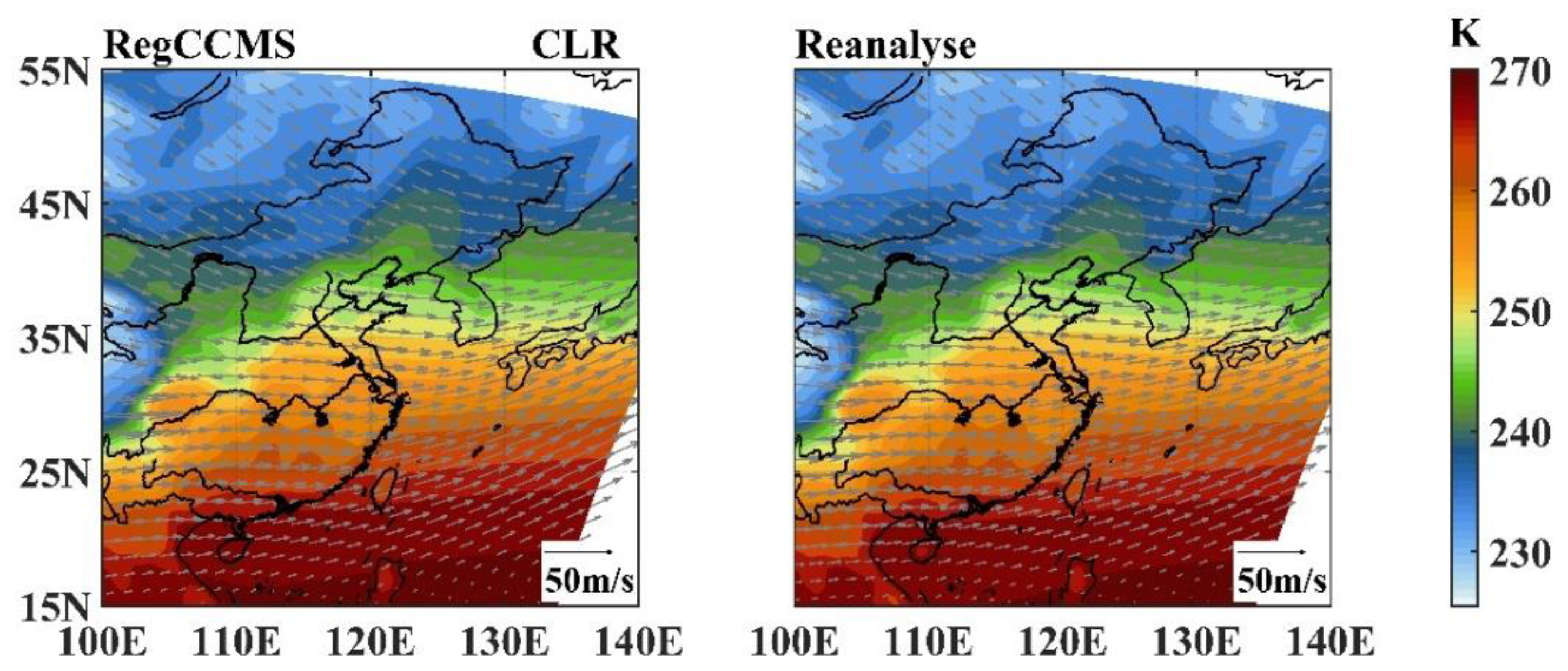



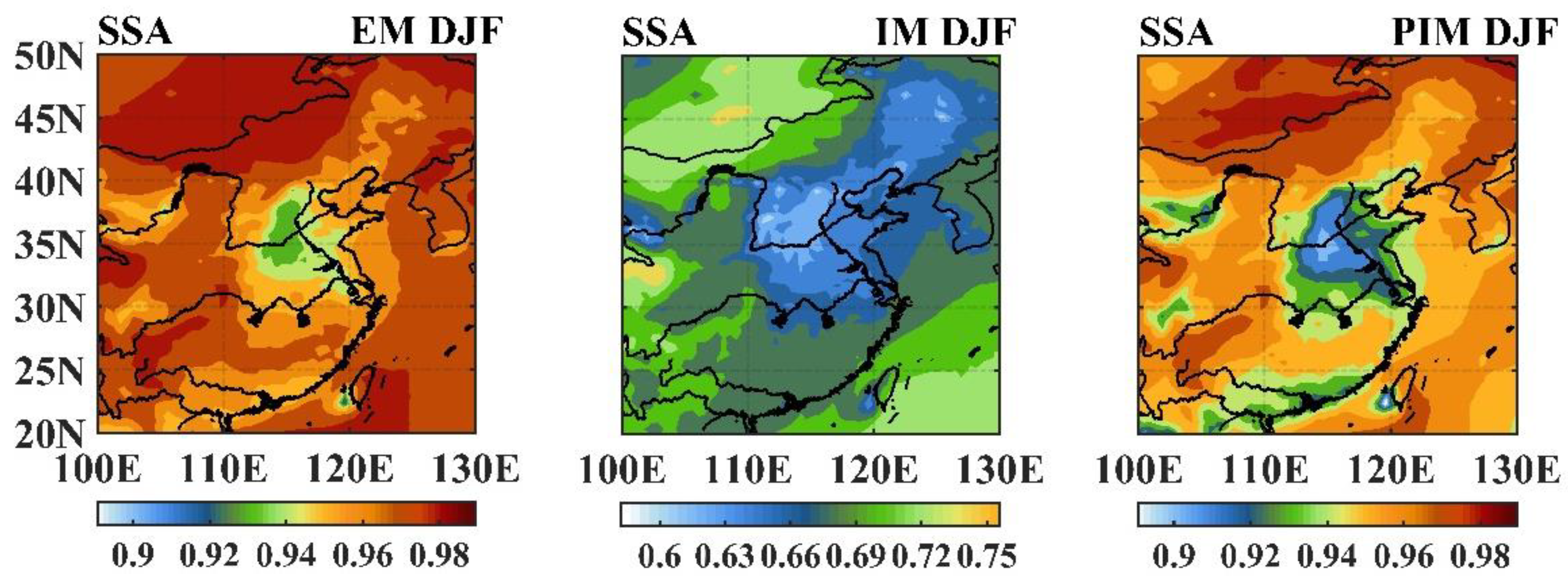



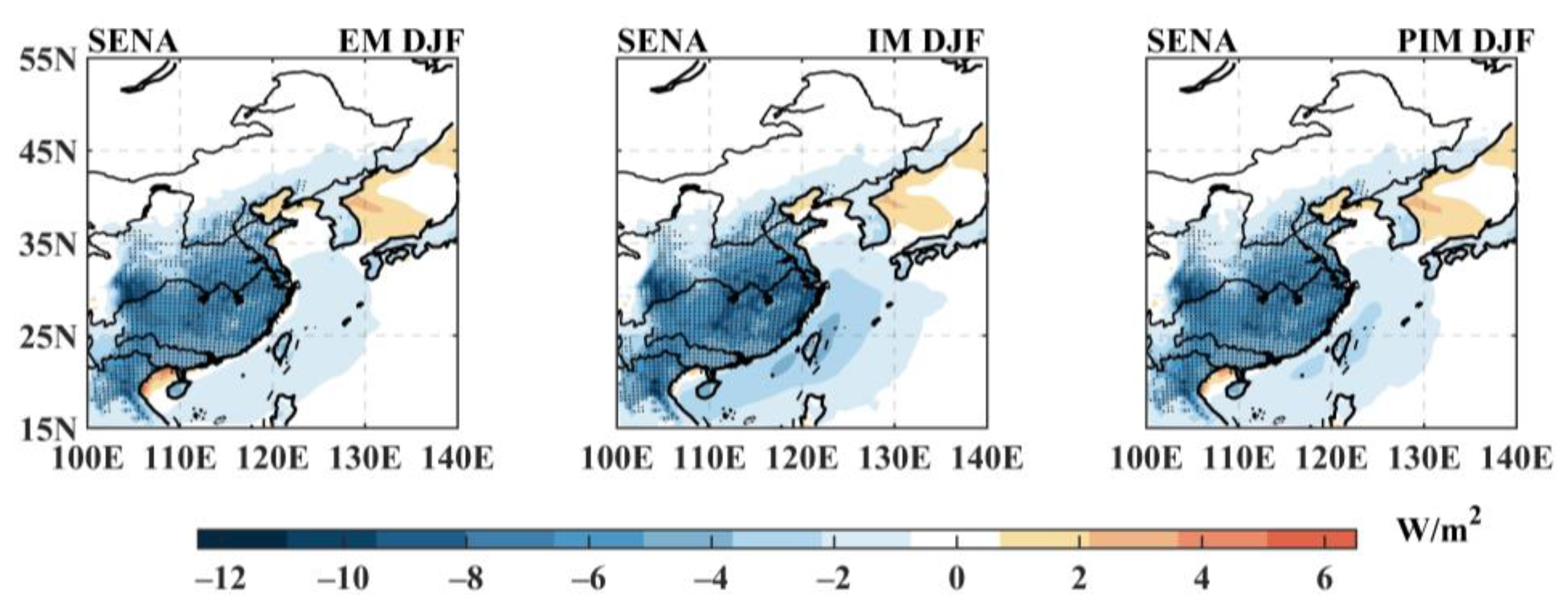
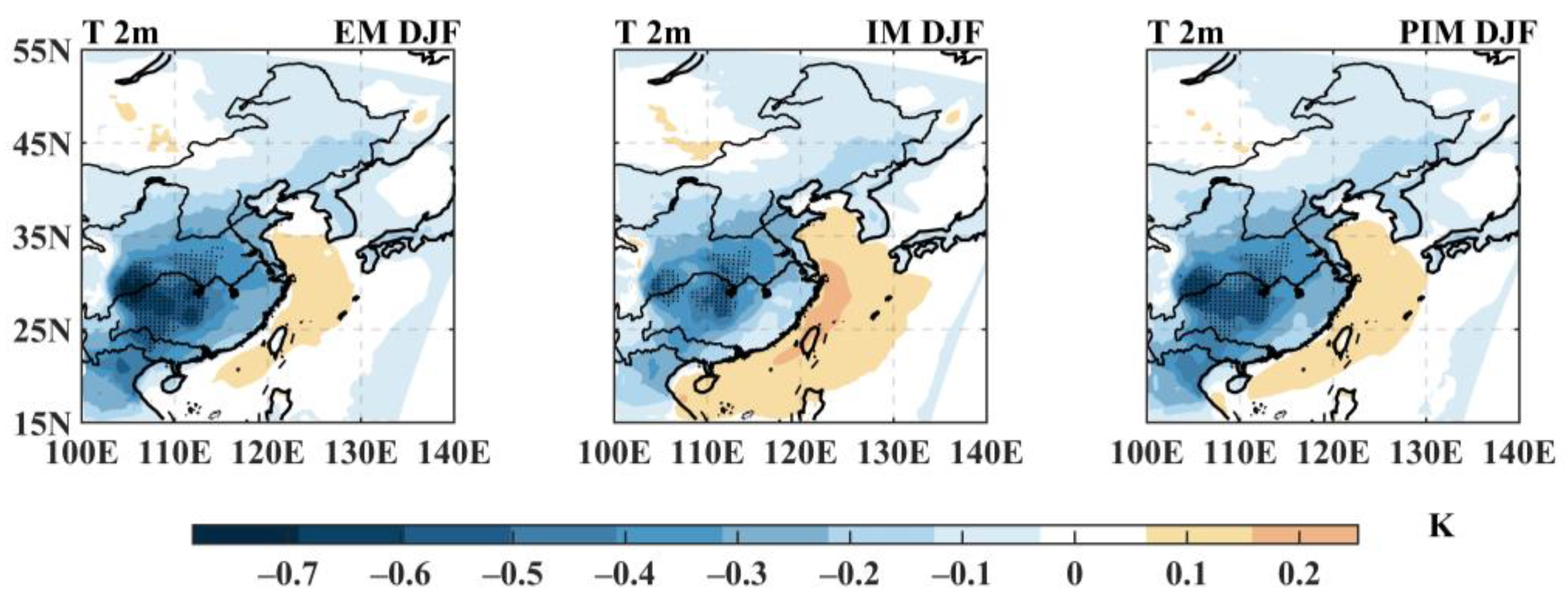


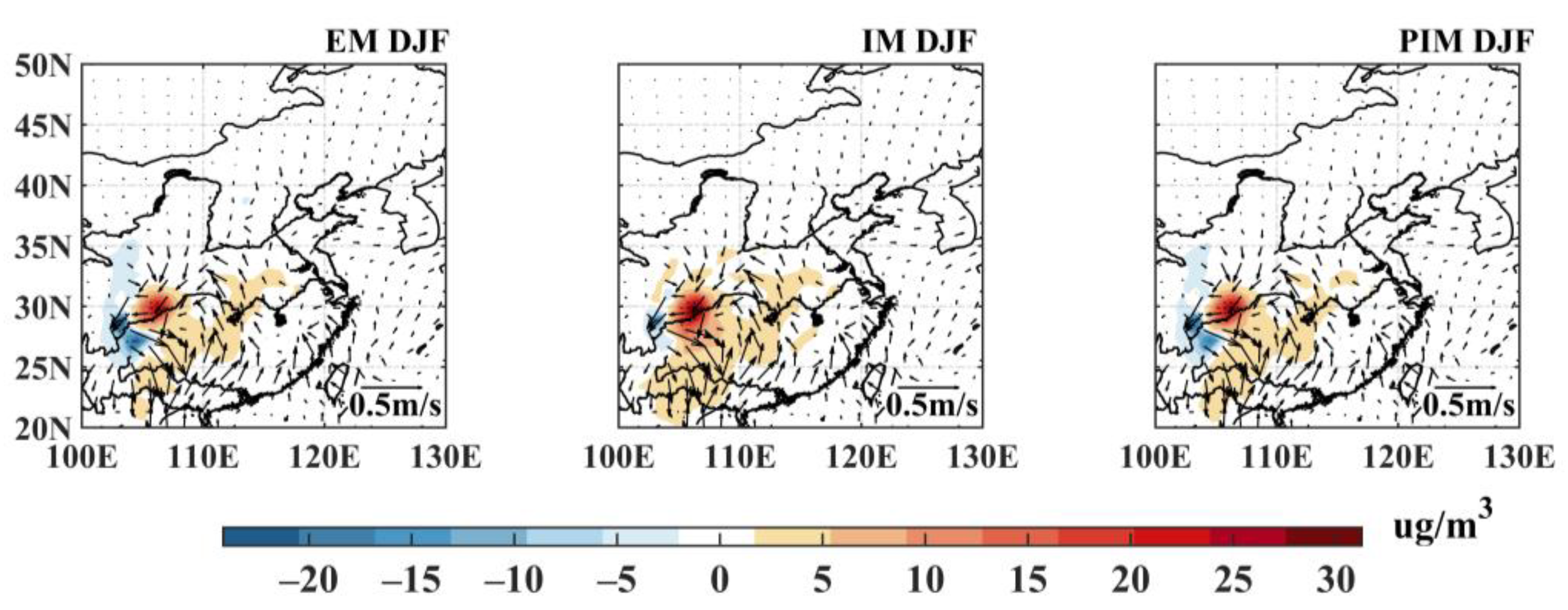
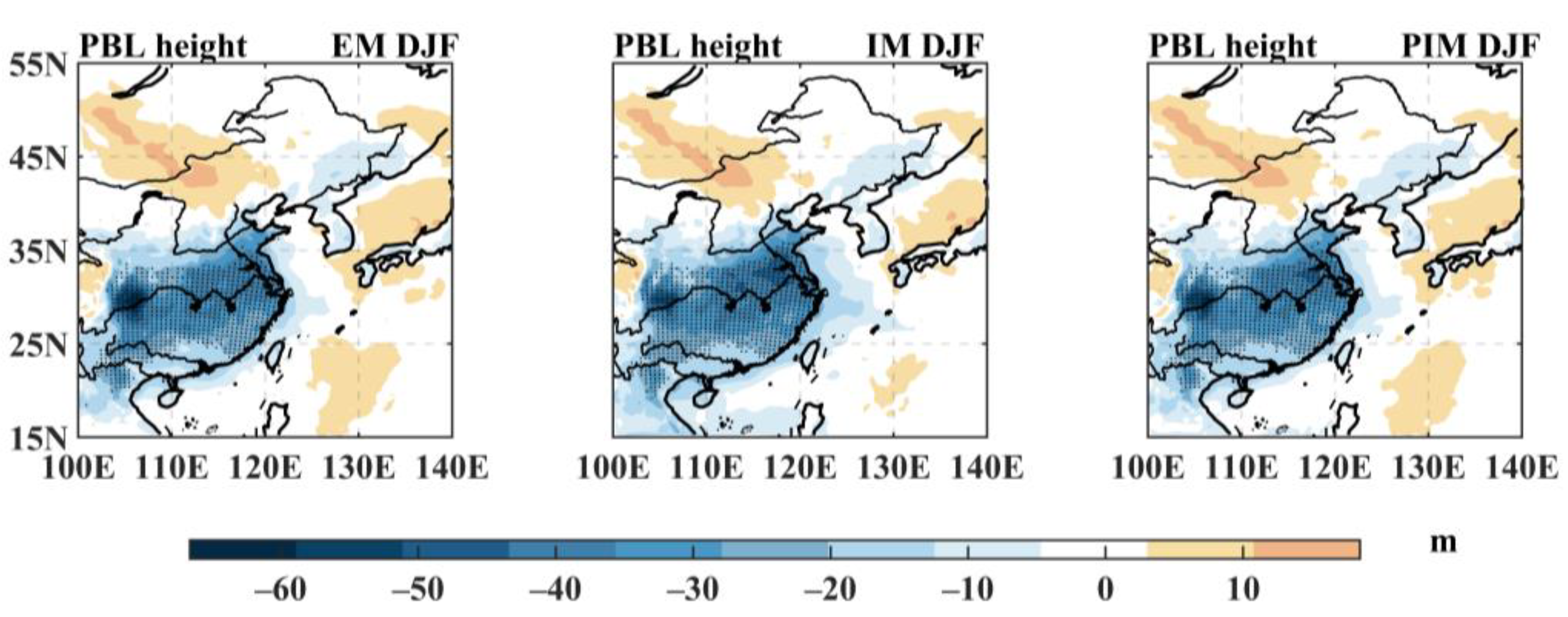

| Numerical Simulation Experiments Done in This Research | |
|---|---|
| Experiment | Experiment content |
| CLR | Does not consider the effects of aerosols. |
| EM | Aerosols are independent of each other and mixed externally. |
| IM | Hydrophilic BC is assumed to be the core, and other hydrophilic aerosols are wrapped around the BC as a shell. |
| PIM | Partial hydrophilic aerosols (32.2%, 32.2%, 35.5% and 48.5% of sulfate, nitrate, black carbon and organic carbon) are internally mixed, and other aerosols are externally mixed. |
| Average Aerosol Concentration in East Asia in Winter | ||
|---|---|---|
| Aerosol Type | Surface (μg/m3) | Column (mg/m2) |
| Total | 18.23 | 39.32 |
| Nitrate | 4.93 | 11.34 |
| Sulfate | 8.14 | 19.90 |
| Black Carbon | 2.23 | 3.46 |
| Primary Organic Carbon | 2.93 | 4.63 |
| Site | Latitude (°N) | Longtitude (°E) |
|---|---|---|
| Chengdu | 30.65 | 104.04 |
| Dalian | 38.9 | 121.63 |
| Gucheng | 39.13 | 115.8 |
| Gaolanshan | 36.0 | 105.85 |
| Jinsha | 29.63 | 114.2 |
| LinAn | 30.3 | 119.73 |
| Longfengshan | 44.73 | 127.6 |
| Lhasa | 29.67 | 91.13 |
| Nanning | 22.82 | 108.35 |
| Panyu | 23.0 | 113.35 |
| Zhengzhou | 34.78 | 113.68 |
| Dunhuang | 40.15 | 94.68 |
| Taiyangshan | 29.17 | 111.71 |
| XiAn | 34.4 | 108.8 |
| Regional Averaged Weather Field Changes in Winter | ||||||
|---|---|---|---|---|---|---|
| Mixing State | Near-Surface Solar Heating Rate (K/day) | Sensible Heat Flux (W/m2) | 2 m Air Temperature (K) | 850 hPa Wind Velocity (m/s) | Precipitation (mm/day) | 850 hPa Humidity (×10−3 g/Kg) |
| EM | 0.18 | −1.87 | −0.11 | 0.06 | −0.02 | −9.47 |
| IM | 0.24 | −2.29 | −0.06 | 0.08 | −0.01 | 4.62 |
| PIM | 0.20 | −1.95 | −0.10 | 0.06 | −0.02 | −8.37 |
Publisher’s Note: MDPI stays neutral with regard to jurisdictional claims in published maps and institutional affiliations. |
© 2022 by the authors. Licensee MDPI, Basel, Switzerland. This article is an open access article distributed under the terms and conditions of the Creative Commons Attribution (CC BY) license (https://creativecommons.org/licenses/by/4.0/).
Share and Cite
Gao, Y.; Zhuang, B.; Wang, T.; Chen, H.; Li, S.; Wei, W.; Lin, H.; Li, M. Climatic–Environmental Effects of Aerosols and Their Sensitivity to Aerosol Mixing States in East Asia in Winter. Remote Sens. 2022, 14, 3539. https://doi.org/10.3390/rs14153539
Gao Y, Zhuang B, Wang T, Chen H, Li S, Wei W, Lin H, Li M. Climatic–Environmental Effects of Aerosols and Their Sensitivity to Aerosol Mixing States in East Asia in Winter. Remote Sensing. 2022; 14(15):3539. https://doi.org/10.3390/rs14153539
Chicago/Turabian StyleGao, Yiman, Bingliang Zhuang, Tijian Wang, Huimin Chen, Shu Li, Wen Wei, Huijuan Lin, and Mengmeng Li. 2022. "Climatic–Environmental Effects of Aerosols and Their Sensitivity to Aerosol Mixing States in East Asia in Winter" Remote Sensing 14, no. 15: 3539. https://doi.org/10.3390/rs14153539
APA StyleGao, Y., Zhuang, B., Wang, T., Chen, H., Li, S., Wei, W., Lin, H., & Li, M. (2022). Climatic–Environmental Effects of Aerosols and Their Sensitivity to Aerosol Mixing States in East Asia in Winter. Remote Sensing, 14(15), 3539. https://doi.org/10.3390/rs14153539








